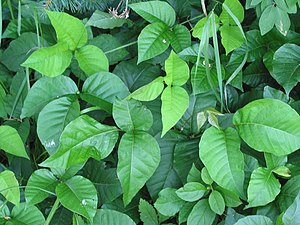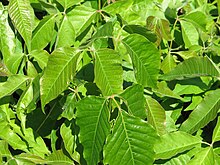Toxicodendron
| Toxicodendron | ||||||||||||
|---|---|---|---|---|---|---|---|---|---|---|---|---|

Poisonous climbing sumac ( Toxicodendron radicans ) |
||||||||||||
| Systematics | ||||||||||||
|
||||||||||||
| Scientific name | ||||||||||||
| Toxicodendron | ||||||||||||
| Mill. |
Toxicodendron is a genus of plants withinthe sumac family (Anacardiaceae). The approximately 30 species are distributed in a disjoint area ; they occur in temperate areas of the northern hemisphere, in Southeast Asia and in the Neotropic. All types produce urushiole , oily substances that can cause severe allergic reactions.
description


Vegetative characteristics
The Toxicodendron species are deciduous, woody plants that grow as shrubs , trees or woody climbing plants. Some species form creeping or climbing runners .
The alternate leaves are arranged in a petiole and a leaf blade. The imparipinnate leaf blade is quite variable depending on the species. While the leaves of Rhus radicans and Rhus diversiloba have three leaflets, there are sometimes five or even seven leaflets; in Rhus vernix it is 7 to 13 and in the lacquer tree 7 to 19 leaflets; there are also species in which is reduced to a leaflet. The leaflets can have smooth, serrated or lobed edges, and all three forms can also be found on one plant specimen.
Generative characteristics
The lateral, racemose or paniculate inflorescences often hang when the fruit is ripe. The bracts fall off early.
The stone fruits are whitish or grayish when ripe.
etymology
The generic name Toxicodendron is derived from the Greek terms τοξικός - toxicos for "poison" and δένδρον - dendron for "tree".
The English trivial names show similarities to other, not closely related plant species and the allergic reaction to the urushiole. The "poison oak" ( Toxicodendron diversilobum , English Poison oak ) is not an oak ( Quercus , beech family ), but got its name because of the similarity of the leaves with those of the white oak ( Quercus alba ). The "poison ivy" ( Toxicodendron radicans , English poison ivy ) is not an ivy ( Hedera , family Araliengewächse ), but has an extremely similar growth form. Actually, the plants contain no poison ( English poison ), but a very aggressive allergen .
Systematics
Some authors classified Toxicodendron as a subgenus Toxicodendron of the genus Rhus . Pell said in 2004 that it is a separate genus and is part of the Rhus complex and that it was considered either as a separate genus or part (subgenus or section ) at different times . Some authors argue that toxicodendron is its own monophyletic genus. There is a controversial discussion about the exact relationships between the Toxicodendron and Rhus complexes. More research is needed.
The approximately 30 species are distributed in a disjoint area ; they occur in temperate areas of the northern hemisphere, in Southeast Asia and in the Neotropic.
There are about 30 species (as of 2019) in the genus Toxicodendron :
- Toxicodendron acuminatum (DC.) CYWu & TLMing
- Toxicodendron bimannii Barbhuiya
- Toxicodendron borneense (Stapf) Gillis
- Toxicodendron calcicola C.Y.Wu
- Toxicodendron delavayi (Franchet) FABarkley
- Toxicodendron diversilobum (Torr. & A. Gray) Greene
- Toxicodendron fulvum (Craib) CYWu & TLMing
- Toxicodendron grandiflorum C.Y.Wu & TLMing
- Toxicodendron griffithii (Hook. F.) Kuntze
- Toxicodendron hirtellum C.Y.Wu
- Toxicodendron hookeri (KCSahni & Bahadur) CYWu & TLMing
- Toxicodendron khasianum (Hook. F.) Kuntze
- Toxicodendron nodosum (Blume) Kuntze
- Toxicodendron orientale Greene
- Toxicodendron pubescens Mill.
- Toxicodendron quinquefoliolatum Q.H.Chen
- Toxicodendron radicans (L.) Kuntze
- Toxicodendron rhetsoides (WGCraib) Tardieu
- Toxicodendron rostratum T.L. Ming & ZFChen
- Toxicodendron rydbergii (Small ex Rydb.) Greene
- Toxicodendron striatum (Ruiz & Pav.) Kuntze
- Toxicodendron succedaneum (L.) Kuntze
- Toxicodendron sylvestre (Siebold & Zucc.) Kuntze
- Toxicodendron trichocarpum (Miq.) Kuntze
- Toxicodendron vernicifluum (Stokes) FABarkley
- Toxicodendron vernix (L.) Kuntze
- Toxicodendron wallichii (Hook. F.) Kuntze
- Toxicodendron yunnanense C.Y.Wu
swell
literature
- Tianlu Min, Anders Barfod: Anacardiaceae. In: Wu Zheng-yi, Peter H. Raven, Deyuan Hong (Eds.): Flora of China. Volume 11: Oxalidaceae through Aceraceae. Science Press and Missouri Botanical Garden Press, Beijing and St. Louis 2008, ISBN 978-1-930723-73-3 . Toxicodendron Miller , pp. 348–352 - online with the same text as the printed work . (Sections Description and Systematics)
- Ze-Long Nie, Hang Sun, Ying Meng, Jun Wen: Phylogenetic analysis of Toxicodendron (Anacardiaceae) and its biogeographic implications on the evolution of north temperateand tropical intercontinental disjunctions. In: Journal of Systematics and Evolution , Volume 47, Issue 5, 2009, pp. 416-430. doi : 10.1111 / j.1759-6831.2009.00045.x full text PDF.
- Ying Jiang, Min Gao, Ying Meng, Jun Wen, Xue-Jun Ge, Ze-Long Nie: The importance of the North Atlantic land bridges and eastern Asia in the post-Boreotropical biogeography of the Northern Hemisphere as revealed from the poison ivy genus (Toxicodendron, Anacardiaceae). In: Molecular Phylogenetics and Evolution , Volume 139, October 2019 doi: 10.1016 / j.ympev.2019.106561 .
Individual evidence
- ↑ a b c d e f g h i j k l m n o p q r s Tianlu Min, Anders Barfod: Anacardiaceae. In: Wu Zheng-yi, Peter H. Raven, Deyuan Hong (Eds.): Flora of China. Volume 11: Oxalidaceae through Aceraceae. Science Press and Missouri Botanical Garden Press, Beijing and St. Louis 2008, ISBN 978-1-930723-73-3 . Toxicodendron Miller , pp. 348–352 - online with the same text as the printed work .
- ↑ a b c d e f g Toxicodendron in the Germplasm Resources Information Network (GRIN), USDA , ARS , National Genetic Resources Program. National Germplasm Resources Laboratory, Beltsville, Maryland. Retrieved August 20, 2020.
- ↑ a b c Ze-Long Nie, Hang Sun, Ying Meng, Jun Wen: Phylogenetic analysis of Toxicodendron (Anacardiaceae) and its biogeographic implications on the evolution of north temperateand tropical intercontinental disjunctions. In: Journal of Systematics and Evolution , Volume 47, Issue 5, 2009, pp. 416-430. doi : 10.1111 / j.1759-6831.2009.00045.x full text PDF.
- ↑ a b c d e f Ying Jiang, Min Gao, Ying Meng, Jun Wen, Xue-Jun Ge, Ze-Long Nie: The importance of the North Atlantic land bridges and eastern Asia in the post-Boreotropical biogeography of the Northern Hemisphere as revealed from the poison ivy genus (Toxicodendron, Anacardiaceae). In: Molecular Phylogenetics and Evolution , Volume 139, October 2019 doi: 10.1016 / j.ympev.2019.106561 .
- ^ D. Gledhill: The Names of Plants , 4th Edition, Cambridge University Press, 2008, ISBN 978-0-521-86645-3 .
- ^ Susan Katherine Pell: Molecular Systematics of the Cashew Family (Anacardiaceae) (PhD dissertation at Louisiana State University) . February 18, 2004. Archived from the original on March 15, 2012.